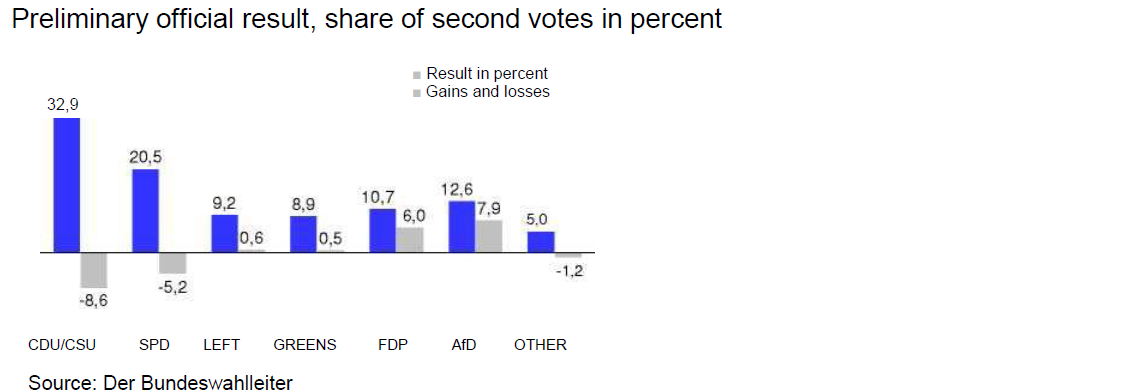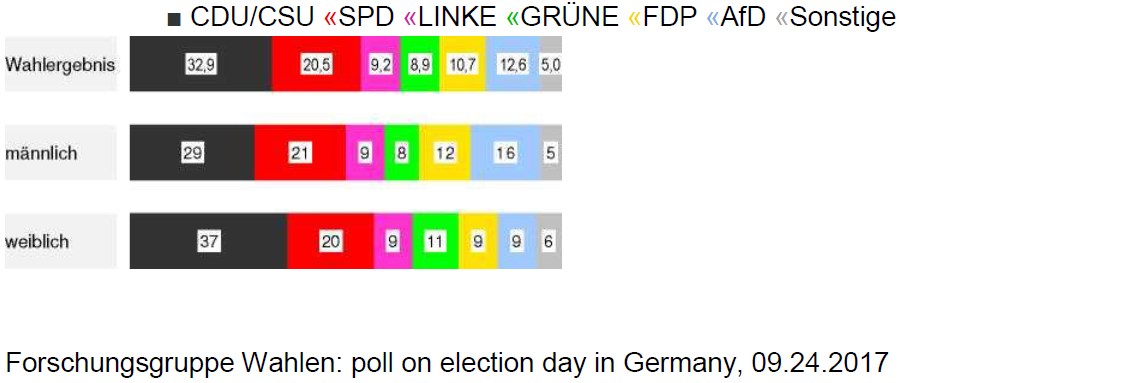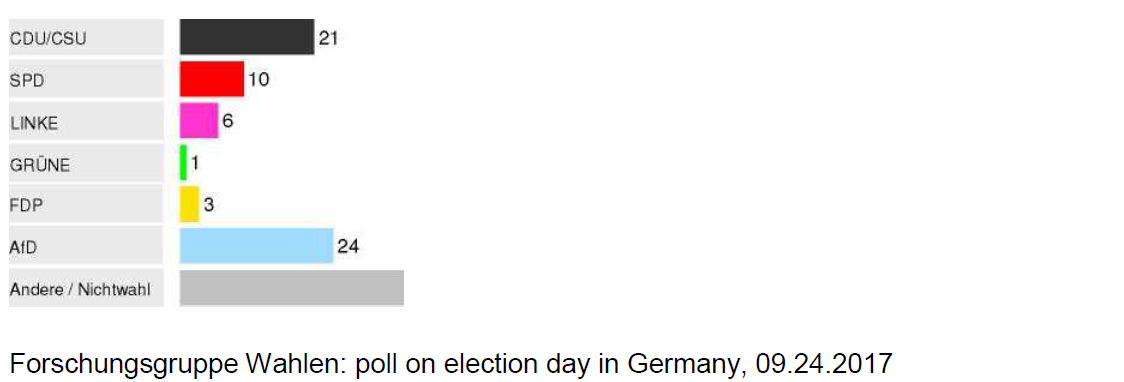Source
Analysis of the Bundestag election
Angela Merkel secures a costly CDU/CSU electoral victory
SPD hits rock bottom, FDP comeback, AfD third-largest party
In the nineteenth election to the German Bundestag, the Union becomes the strongest party for the sixteenth time, though after a record loss it suffered its weakest result since 1949 at 32.9 %. With merely 20.5 %, the SPD dropped to its worst result ever on the federal level. The Left (9.2 %) and the Greens (8.9 %) were able to make marginal gains. After its crash in 2013, the FDP makes a strong parliamentary comeback with 10.7 %, and the AfD represents the first time in 34 years that a new party has won seats, emerging as the third-strongest political force in the German Bundestag with a plus of 12.6 %, which is unusual for Bundestag elections.
Result Bundestag election 2017

Substantially carried by voters of the 60-plus generation with its strong participation rates, the most important reasons behind the victory of the Union are the standing of the party, the work of the government, professional competence, and, of course, Angela Merkel. Flanked by the desire for a Union-led federal government, the CDU/CSU further benefits from the work of a reputation of a chancellor who conveys stability and strong leadership within an economically strong Germany and a fragile global environment. Even if Angela Merkel by now has a partially polarizing effect, 73 % of Germans – almost the outstanding average of the last twelve years – attest that she has done good work as chancellor.
Fifty-six percent of Germans prefer Angela Merkel as federal chancellor and only 34 % Martin Schulz (SPD), which, apart form the strong performance of the incumbent, also has to do with the SPD candidate. When it comes to the image on the +5/-5 scale, Schulz does better at 1.0 than Peer Steinbrück did in 2013 (0.7), but he is far behind Merkel’s high reputation (1.8; 2013: 2.1), who is seen as more sympathetic, credible, and above all competent than Schulz. Seventy percent of those polled think that Merkel is helpful to the election performance of the CDU/CSU, only 32 % believe that about Schulz and the SPD (is detrimental: 9 % and 23 %; neither/nor: 17 % and 40 %).
With German citizens assessing their private as well as the general domestic economic situation as positively as never before in a Bundestag election, while at the same time 67 % think we are “living in particularly uncertain times worldwide,” external political aspects are highly relevant alongside economic ones: clearly superior to the SPD when it comes to the economy and jobs, the CDU/CSU is also believed to be more capable in foreign affairs. Fifty-nine per cent believe Angela Merkel “is more likely to guide Germany through uncertain times,” and only 11 % think so of Martin Schulz.
After its symptomatic deficits in its top candidate and on economic issues, the SPD is able to score points – apart from family policy – on social justice, though here it is competing more strongly than in 2013 with the Left. In a country in which 82 % of those polled believe that the differences between the poor and the rich have grown in recent years, the Left is for 81 % of its voters “the only party that is pursuing policies for the socially disadvantaged.”
Party competence in the areas of

Refugees/asylum
Pension/old-age provision
Social justice
Education/Schools
Jobs
Party competence in the areas of

Crime
Family
Environment
Foreign policy
Economy
On the top issue of refugees, 35 % of those polled feel most strongly represented by the CDU/CSU, only 15 % by the SPD, and 12 % by the AfD. Contrary to the optimistic basic mood, 87 % of AfD voters (all respondents: 37 %) doubt that Germany can cope with the many refugees. Ninety-eight per cent of AfD voters (all respondents: 43%) criticize Merkel’s refugee policy, with the federal government also serving, alongside the chancellor, as the target of their discontent: only 25 % of all respondents, but 83 % of AfD voters are unhappy “all in all” with the work of the Grand Coalition.

As a political communicator, the AfD thus absorbs the protest, worries, and discontent of a group of voters who – with parallels to the Left – complain that the prosperity gap has grown substantially and that Germany is poorly prepared for the future. Highly regarded as a party by its own supporters, the AfD has by now moved far to the right in the eyes of all Germans, when it comes to its image it plunges to a miserable -2.8 (2013: -1.4).
While the Left and the Greens have a more moderate or slightly better reputation, they get poor grades for their work as the opposition. By contrast, the FDP achieves an unprecedented image correction, this time without any demonstration of parliamentary accomplishments. Apart from a fairly large degree of confidence in its tax and educational policy, it profits from its top candidate Christian Lindner as well as from tactical motivations in the Black-Yellow camp: over a third of FDP voters like the CDU or the CSU better as a party.
As usual, the Union achieved its best results – though likewise with noticeably losses – with 41 % among all voters over sixty, and here specifically among women over sixty, with 46 %, whereby the gender gap was also large overall: 37 % of all women, but only 29 % of men voted for the CDU/CSU. The AfD is substantially stronger among men than women (16% vs. 9%), in the East the AfD is even a little stronger than the CDU.
Voting according to gender

Voting in the age groups

The FDP, like the Greens significantly stronger in the west than in the east of the republic, achieved a disproportional result among voters 30 and under, with 13 %. The Liberals were especially popular among the self-employed. The FDP is relatively weak among the unemployed or union members, where the SPD remains the strongest party.
While the Greens preserved their domain in large cities and among university graduates, the Left is overall more than twice as strong in the East than the West, though it is losing its status as the second-largest political force: in eastern Germany, the AfD is leaving the Left clearly behind in the overall result.
Where do the voters of the AfD come from? Today’s AfD voters voted as follows in 2013:

With a great deal of political interest, but also strong dissatisfaction among certain segments of the population, voter turnout rose significantly to 76.2% (+4.6%). Now that the Bundestag will be more fragmented than it has been in six decades, with the FDP and the AfD, which is mobilizing many former non-voters, in addition to a Grand Coalition, only a “Jamaica” coalition is for all practical purposes capable of holding a majority. However, unlike in 2013, a coalition between the Union and the SPD is strongly polarizing (good: 40%; bad: 43%; indifferent: 14%), and there are noticeable reservations about a government composed of the CDU/CSU, the FDP, and the Greens (good: 30%; bad: 47%; indifferent: 20%).
[…]
Source: Forschungsgruppe Wahlen e.V., Bundestagswahl 24 September 2017, http://www.forschungsgruppe.de/Aktuelles/Wahlanalyse_Bundestagswahl/Newsl_Bund_170928.pdf.